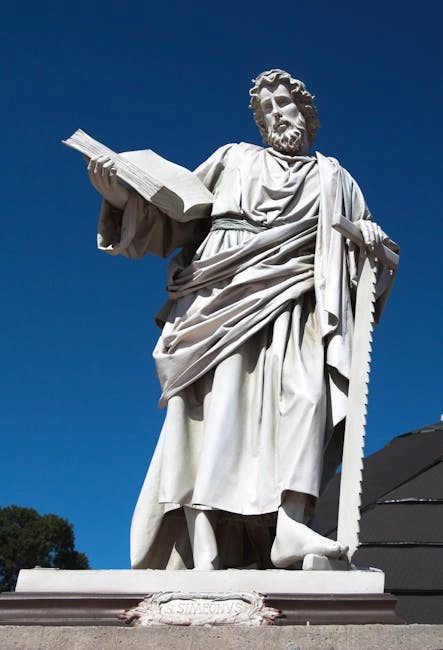apostle paul timeline pdf

apostle paul timeline pdf
Explore the transformative journey of Apostle Paul, from his conversion to his missionary endeavors and martyrdom, shaping early Christianity through his teachings and epistles.

Overview of Paul’s Life and Ministry
Apostle Paul, born around 5 AD in Tarsus, was a Roman citizen and Pharisee. His life transformed after a divine encounter on the Damascus Road in 37 AD. He became a passionate missionary, spreading Christianity across the Mediterranean. Paul undertook three major missionary journeys, establishing churches and writing influential epistles. His teachings emphasized salvation through faith in Jesus Christ, impacting early Christian doctrine. Despite facing persecution, imprisonment, and eventual martyrdom in Rome around 65 AD, Paul’s legacy endures as a foundational figure in Christianity, shaping its theology and practice for centuries;

Early Life and Education
Born in Tarsus, Paul was a Roman citizen and Pharisee, educated under Gamaliel in Jerusalem, immersed in Jewish law and tradition, shaping his early identity.
Birth and Background
Apostle Paul, born in Tarsus, Cilicia, around 5-15 AD, was a Roman citizen and a Jew from the tribe of Benjamin. His dual identity as a Roman citizen and a Pharisee provided a unique foundation for his future ministry. Paul’s early life was marked by a strict adherence to Jewish traditions and a thorough education under Gamaliel in Jerusalem, which deeply influenced his understanding of the law and prepared him for his role as a religious leader. This background played a pivotal role in shaping his theological perspectives and missionary work.
Training Under Gamaliel
Paul’s education under Gamaliel, a renowned Pharisee and scholar, significantly shaped his theological foundations. In Jerusalem, Gamaliel’s teachings emphasized strict adherence to Jewish law and traditions, fostering Paul’s deep understanding of Scripture. This training not only honed his skills in religious debate but also instilled in him a zealous commitment to Pharisaic ideals. Paul’s time with Gamaliel prepared him to become a respected teacher and defender of Jewish traditions, which later contrasted with his transformative embrace of Christianity after his encounter on the Damascus Road.

Conversion and Early Ministry
Paul’s life transformed after his Damascus Road encounter with Christ, shifting from persecution to preaching. He ministered in Damascus, Arabia, and Jerusalem, facing intense opposition early on.
The Damascus Road Experience
Paul’s dramatic conversion occurred on the Damascus Road when a blinding light appeared, and Jesus spoke to him. This pivotal moment transformed him from a persecutor of Christians to a devoted follower. The encounter left him temporarily blind and led to his baptism by Ananias. With a newfound mission, Paul began preaching about Christ, despite facing immediate opposition. This event, recounted in Acts 9:1-18, 22:6-21, and 26:12-18, marked the beginning of his ministry and his role as a key figure in spreading Christianity.
Initial Preaching and Persecution
After his Damascus Road conversion, Paul immediately began preaching about Jesus in Damascus and Jerusalem, astonishing his audience with his sudden transformation. His bold declaration of Christ as the Messiah angered Jewish leaders, leading to intense persecution. Fleeing to Tarsus for safety, Paul continued his ministry, spreading the Gospel to Jews and Gentiles alike. Despite the opposition, his unwavering faith and persuasive teachings laid the foundation for his future missionary journeys. This period marked the beginning of his lifelong commitment to sharing the message of salvation through Jesus Christ.

Missionary Journeys
Paul embarked on three extensive missionary journeys, spreading Christianity across the Mediterranean, establishing churches, and preaching to both Jews and Gentiles, despite facing numerous challenges and persecutions.
First Missionary Journey (45-47 AD)
Paul’s first missionary journey began in Antioch, where he and Barnabas were commissioned by the church. They traveled to Cyprus, preaching in synagogues, and then to Galatia, establishing churches in cities like Iconium, Lystra, and Derbe; Despite facing opposition and persecution, including being stoned in Lystra, Paul persevered, spreading the Gospel to both Jews and Gentiles. This journey marked the beginning of Paul’s extensive missionary work, laying the foundation for the spread of Christianity beyond Jerusalem. The journey concluded with their return to Antioch, where they reported on their successes and challenges to the church.
Second Missionary Journey (51-54 AD)
Paul’s second missionary journey began in Antioch, accompanied by Silas, Timothy, and Luke. They revisited churches in Galatia and Asia Minor, strengthening existing communities; In Troas, Paul received a vision to preach in Macedonia, leading him to Philippi, where he and Silas were imprisoned but miraculously freed. They continued to Thessalonica and Berea, facing both acceptance and persecution. In Athens, Paul delivered his famous sermon on Mars Hill, engaging Greek philosophers with the Gospel. This journey concluded in Corinth, where Paul stayed for 18 months, establishing a vibrant church. His teachings during this period deeply influenced early Christian theology and practice.
Third Missionary Journey (54-58 AD)
Paul’s third missionary journey focused on strengthening churches in Asia Minor and Greece, with Ephesus as his base. He spent over two years there, teaching and mentoring leaders. In Corinth, he wrote 2 Corinthians, addressing church issues. Paul also faced opposition, including a plot against him in Ephesus. He revisited churches in Macedonia and Greece, ensuring their spiritual growth. This journey concluded with Paul’s final visit to Jerusalem, where he was falsely accused and arrested, marking the end of his missionary travels and the beginning of his imprisonment. His efforts during this period solidified his legacy as a pivotal figure in Christianity.

Imprisonment and Later Life
Paul was imprisoned in Caesarea and later in Rome, where he wrote several epistles. After release, he continued ministry, possibly visiting Spain, before martyrdom in Rome around 65 AD.
Arrest in Jerusalem and Imprisonment in Caesarea
Paul’s ministry in Jerusalem led to his arrest due to unrest caused by his teachings. He was detained in Caesarea for two years under Governors Felix and Festus. During this time, he defended his faith before officials and appealed to Caesar, invoking his Roman citizenship. This period marked a significant shift in Paul’s missionary work, as he transitioned from active evangelism to a life of imprisonment, yet continued to spread his message through epistles and interactions with his captors. His imprisonment in Caesarea was a pivotal moment in his journey toward eventual martyrdom in Rome.
Imprisonment in Rome and Later Ministry
Paul was imprisoned in Rome around 61-63 AD, where he wrote epistles like Ephesians, Philippians, Colossians, and Philemon. Despite captivity, he continued to preach and mentor believers, emphasizing grace and faith. After release, he likely ministered in Spain and wrote additional letters, including 1 Timothy and Titus. Rearrested later, he endured harsher conditions but remained steadfast in his faith. His imprisonment in Rome signifies his unwavering commitment to spreading Christianity, even in the face of adversity, leaving a lasting legacy through his writings and teachings.

Legacy and Martyrdom
Paul’s martyrdom in Rome around 65 AD cemented his legacy as Christianity’s foundational figure. His epistles, emphasizing grace and faith, profoundly shaped Christian doctrine, inspiring countless believers and the expansion of the Church.
Contributions to Christianity
Apostle Paul’s contributions to Christianity are monumental. He authored 13 New Testament epistles, establishing key doctrines like salvation by grace through faith. His missionary journeys planted churches across the Mediterranean, spreading the Gospel to Gentiles and unifying Jewish and Gentile believers. Paul’s theology emphasized the centrality of Christ’s resurrection and the inclusion of all people in God’s covenant, transforming Christianity into a global faith. His letters remain foundational for Christian theology, ethics, and church practice, making him one of the most influential figures in Christian history.
Martyrdom in Rome
Apostle Paul’s life culminated in martyrdom during Emperor Nero’s reign around 65 AD. According to tradition, he was beheaded outside Rome near the Ostian Way. This execution occurred during a period of persecution against Christians, with Nero blaming them for the Great Fire of Rome in 64 AD. Paul’s martyrdom marked the end of his earthly ministry but cemented his legacy as a faithful witness to the Gospel. His death, along with Peter’s, symbolized the suffering endured by early Christians yet underscored their unwavering commitment to their faith. This event remains a pivotal moment in Christian history.